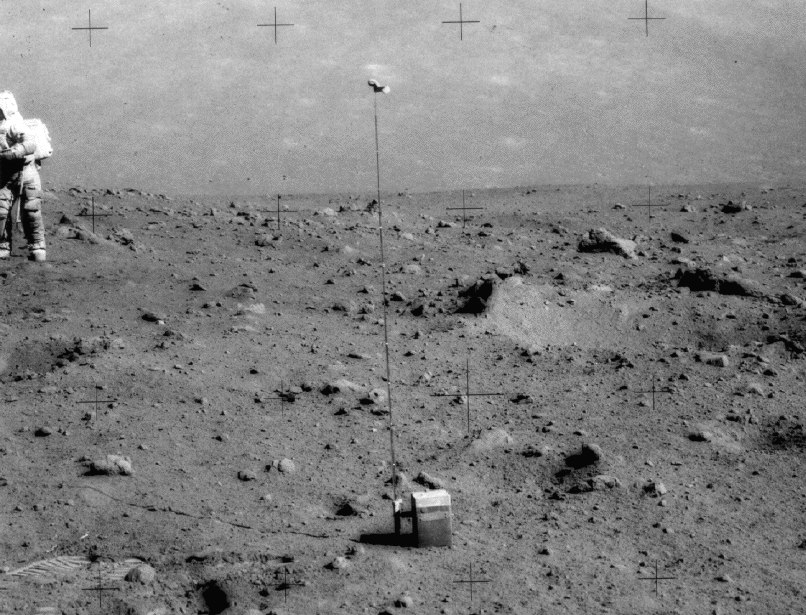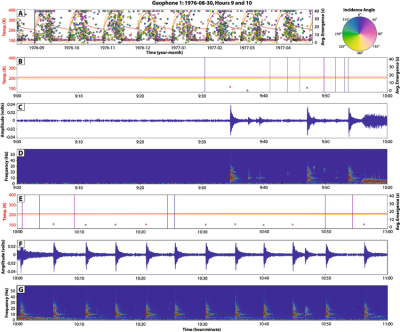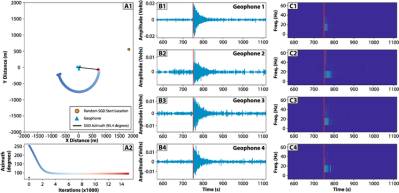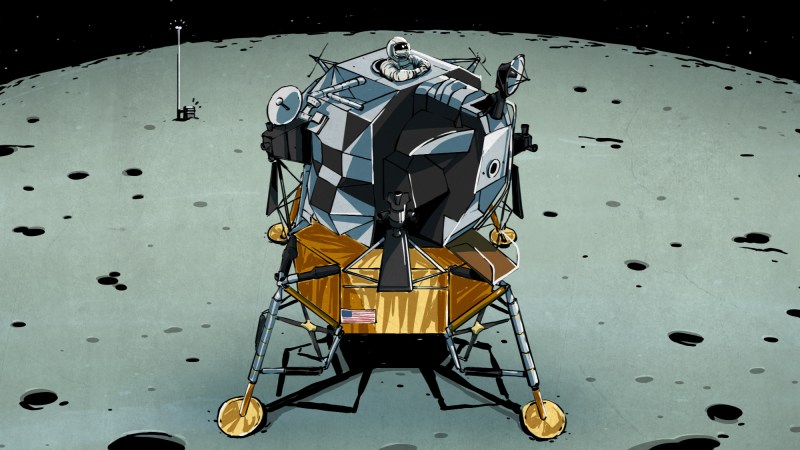In the vast realm of space exploration, new discoveries often emerge from old data. Thanks to advanced algorithms and keen observers, the seismic activities of our closest celestial neighbor, the Moon, have recently been thrust back into the limelight.
Thanks to the effort of the NASA crew involved in the Apollo 17 mission, it’s possible investigate these phenomena today with datasets from the past. Recently, researchers working with this data turned up some intriguing findings, and published them in a new paper. It reveals that one unexpected source of moonquakes could be the very equipment that Earth’s astronauts left behind.
The Lunar Seismic Profiling Experiment

The Apollo 17 mission in 1972 was more than just the final time man would walk on the moon. It also involved the deployment of a lesser-known experiment, known as the Lunar Seismic Profiling Experiment (LSPE). It built upon the earlier Active Seismic Experiment deployed by Apollo 14 and Apollo 16, and aimed to explore the subsurface lunar structure. To achieve this, the astronauts deployed four geophones – sensitive seismic devices – that captured vibrations from deliberate explosive detonations to map out the near-surface structure of the Moon.

Post-mission, the equipment was left behind to operate in passive recording mode, picking up seismic signals autonomously. Thousands of moonquakes were documented over an 8-month span from October 1976 to May 1977. Researchers were able to categorize these due to different causes. Unlike on Earth, these aren’t caused by the shifting of large tectonic plates. So-called “deep” moonquakes are thought to be caused by tidal forces generated by the Earth, while mysterious “shallow” moonquakes are a bit more of a mystery. Others are believed to be caused by meteorite impacts. There are also so-called “thermal” moonquakes caused by the heating and cooling of the Moon’s crust as the sun warms its surface and moves away again. With parts of the surface swinging from -133 C to 121 C through the transition from lunar day to lunar night, it’s a major source of seismic activity. New research into the data has since revealed a further category of moonquake, however, with an altogether more human origin.
Shake It Like a Lunar Lander

Caltech researchers, using machine learning techniques, dove deep into the Apollo 17 seismic data and unraveled an astounding revelation. Regular moonquakes occurred predictably every lunar afternoon as the surface cooled. Yet, every lunar morning, a set of unusual repeating signals popped up.
The impulsive signals differed from the more typical emergent events that were well-established as thermal quakes caused by sunlight on the moon’s surface. Triangulating the high-amplitude seismic signals revealed them to be coming from the vicinity of the Apollo 17 lander itself.
Indeed, these vibrations appeared to be the were the echoes of the Apollo 17 lander’s interactions with the rising sun. “Every lunar morning when the sun hits the lander, it starts popping off. Every five to six minutes another one, over a period of five to seven Earth hours. They were incredibly regular and repeating,” noted Allen Husker, a co-author of the research paper. As the lander responded to the morning warmth, it naturally expanded with the heat, with its creaking vibrations becoming distinct seismic signals. The geophones, being in close proximity, picked them up.

There is hope that further seismic research could reveal more of the Moon’s secrets, too. Husker notes that it could be possible to search for subsurface craters or other deposits beneath the Moon’s surface. A geophone array installed on parts of the Moon that never see sunlight could be of particular value, allowing scientists to hunt for water ice trapped on the Moon, since seismic waves travel more slowly through that material.
The discovery, while fascinating, offers more than just a curious factoid about space exploration. It’s a poignant reminder of the lasting impact of our space endeavors, even those decades old. This research underscores the necessity of understanding both natural and artificial influences on lunar seismic activity. More than that, it shows how our own exploration of space can have an impact on other worlds. To say nothing of the contamination that can be spread by human probes and the quarantine protocols we should be adhering to.
Fundamentally, the Apollo 17 findings remind us that sometimes, to find the most unexpected answers, we must first look at our own footprint.

















https://en.wikipedia.org/wiki/Hollow_Moon
As Peter Harness confidently accounted the moon is in fact an egg, due to hatch into a butterfly type creature only to be replaced once the hatchling lays an identical moonegg.
No scientific evidence exists to support the idea.
Get in the locker, nerd.
HAHAHAHAHAH!!!!
If only they had kept on recording past the original time period of from October 1976 to May 1977. they could have picked up Beresheet, Chandryaan-2, Luna-25, Hakuto-R Mission 1
Glad to see apollo 17’s finally getting called out, its behavior has been completely inappropriate for far too long
B^)
Apollo 17 moon quakes ??? So the moon is a pretty quiet place and we put some damn sensitive devices there ….
I was working at the Merritt Island USB station on Kenedy Space Center during Apollo 17. After the crew departed they ignited several explosive charges that were recorded on a seismograph and I remember the moon ringing like a bell for several minutes.
This summer I started wondering whether the moon has an effect on earthquakes, and put together the software needed to grab earthquake data and moon info (position, subpoint, &c) to see if they correlate.
It’s a thorny problem. Given the lat/lon/time of an earthquake and the position of the moon, what is the right correlation to look for?
If anyone has a suggestion, I’d be obliged.
(I did a literature search first. General opinion is that the moon does *not* contribute to earthquakes, but there was some doubt, and I also wanted to to the exercise to convince myself.)
Without having any expert knowledge on this, I would expect you would want to find some correlation with tides near to the area. The water is giving you a pretty simple report on the periodic timing / degree of the moon’s gravitational influence on the area. I’d expect 0°, 90°, 180°, etc. (The moon’s east-west loc relative to area being investigated) to represent the extremes of its imparted force.
I’d start by plotting number of earthquakes by epicenter distance to the moon. That should show if there is any obvious correlations, be it “on the opposite side”, “on the same side” or something else.
Step 1 would be get squared away on the definition of “epicenter”. It’s not what you appear to think it is.
Oh, what a sensationalist headline!
The Apollo 17 lander is NOT causing moonquakes. It is creaking due to thermal expansion when the sun hits it, and the quake detector is detecting these due to is proximity.
There’s a big difference between a moonquake and a creaking metal joint.
Yup, exactly what I was thinking. The only real “news” here is that the equipment is sensitive enough to detect the contraction/expansion, even at the distance…still not really news, but as close as you can get on this one.
Just feels like the self hate group was looking for something more to self hate over. Not sure why HaD would promote that though….
“the final time man would walk on the moon.” I can’t accept the absolutism in that statement. Oh so pessimistic. I would have worded it “the most recent time man would walk on the moon.”
And, from the title, I thought it would be some sort of criticism of Apollo 17.
But enough complaints – this is a very nice article. Thanks for publishing it.
Yeah. We’ve abandoned manned space exploration for half a century and likely lost the expertise needed to build upon it so I’m looking forward to being proven wrong (I would like that very much please)
Dummy here. Where are the “parts of the Moon that never see sunlight” ?
Maybe in a crater near one of the poles? That’s all I can think of…
Yes, that’s correct.
The rectums of the aliens living inside The Moon?
Everyone knows the mooninites have bioluminescent rectums!
Look into PSRs, Permanently Shadowed Regions. Earlier this year, I was fortunate enough to see some work going on at UTEP involving the processes to be used to harvest ice from those regions. Literally things straight out of SciFi movies.
The ice “where the sun don’t shine” that is, craters with sides deep in shadow, is going to be interesting to science as it will be ancient ice deposits. It remains untouched not like the ice from comets that hit the earth when it was cooling.
Bit afraid to ask—what causes the sky to be that shade in the photograph of the geophone?
That’s most likely a hill, crater or other moonscape feature.
Sky? They landed in the Taurus-Littrow Valley.
Yeah that’s a distant hill. No sky is visible in that picture.
“Once Upon a Time…a junkman had a dream…”I wanna build a spaceship, go to the moon, salvage all the junk that’s up there, sell it.””
Nope, you’re not the only one who remembers.
https://www.imdb.com/title/tt0078681/
“More than that, it shows how our own exploration of space can have an impact on other worlds. To say nothing of the contamination that can be spread by human probes and the quarantine protocols we should be adhering to.”
Like contaminating Mars with human occupancy before evidence of past or current indigenous life which may have evolved there independently is found which would be one of the most important scientific finds of all time because it would imply that life may be common in the universe? The claimed goal of preventing human extinction with Martian occupancy would be accomplished sooner, cheaper, and easier by just spending a more on planetary defense.
Astrobiology Vol. 17, No. 10
Searching for Life on Mars Before It Is Too Late
1 Oct 2017
Abstract excerpt:
Planetary Protection policies as we conceive them today will no longer be valid as human arrival will inevitably increase the introduction of terrestrial and organic contaminants and that could jeopardize the identification of indigenous Martian life.
————-
On SPAM in a Can spaceflight in general, the reason no human has gone to the moon in over 50 years is because the scientific value versus cost wasn’t worth it even 50 years ago. That was a national prestige contest between the US and the Soviet Union just as the current plan to go back to the moon has become v2.0 of that with the NASA head explicitly stating that the US is in a “race” with China. WHY? Because the bloated legacy aerospace firms, remnants of the 1960s, want that. The unaffordably expensive SLS at $4.2 BILLION PER launch is just one example of the result. The ISS is a lingering example of the SPAM in a Can era that costs as much per year just to support as the lifetime mission cost of one of our nuclear powered rovers on Mars. Which of those is more scientifically valuable? The excuse that the public will only support the NASA budget if SPAM in a Can is part of it is fallacious. Even during Apollo, the public very quickly got bored whereas images via the eyes of robotic probes have caused the greatest number of hits on NASA/JPL web sites.
Book – The End of Astronauts: How Robots are the Future of Exploration (2022)
My TIN Foil hat is telling me that this is propaganda
Exactly! Wake up, sheeple! These aren’t “moon quakes” but standard earthquakes because the studio this was filmed in is in L.A. Probably the new regular ones are from passing trucks.
Surely the tidal influence of Earth on moonquakes would be cyclical, periodic, literally menstrual? What do did am are those datums say?